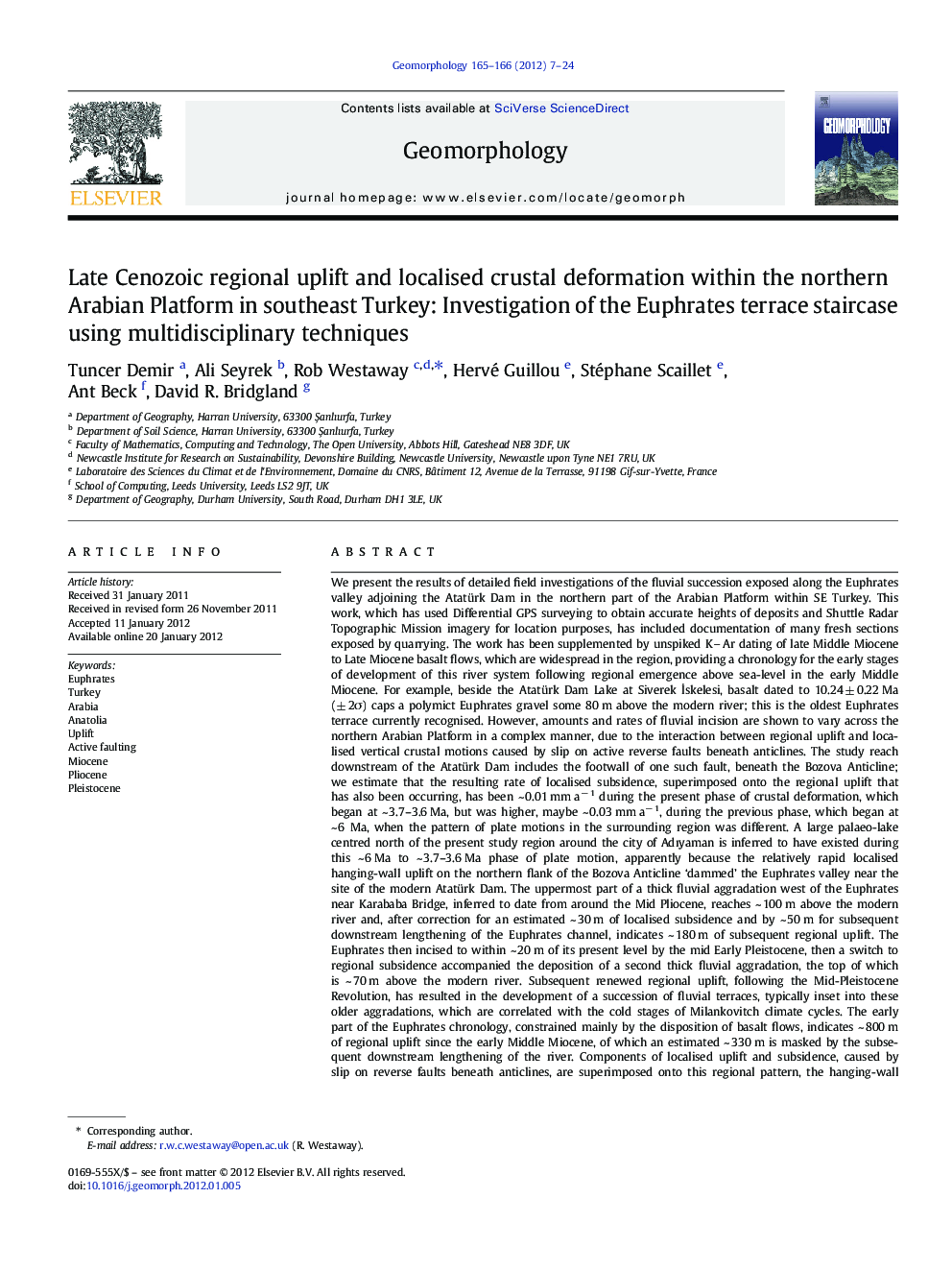| کد مقاله | کد نشریه | سال انتشار | مقاله انگلیسی | نسخه تمام متن |
|---|---|---|---|---|
| 6432911 | 1635476 | 2012 | 18 صفحه PDF | دانلود رایگان |

We present the results of detailed field investigations of the fluvial succession exposed along the Euphrates valley adjoining the Atatürk Dam in the northern part of the Arabian Platform within SE Turkey. This work, which has used Differential GPS surveying to obtain accurate heights of deposits and Shuttle Radar Topographic Mission imagery for location purposes, has included documentation of many fresh sections exposed by quarrying. The work has been supplemented by unspiked KAr dating of late Middle Miocene to Late Miocene basalt flows, which are widespread in the region, providing a chronology for the early stages of development of this river system following regional emergence above sea-level in the early Middle Miocene. For example, beside the Atatürk Dam Lake at Siverek Ä°skelesi, basalt dated to 10.24 ± 0.22 Ma (± 2Ï) caps a polymict Euphrates gravel some 80 m above the modern river; this is the oldest Euphrates terrace currently recognised. However, amounts and rates of fluvial incision are shown to vary across the northern Arabian Platform in a complex manner, due to the interaction between regional uplift and localised vertical crustal motions caused by slip on active reverse faults beneath anticlines. The study reach downstream of the Atatürk Dam includes the footwall of one such fault, beneath the Bozova Anticline; we estimate that the resulting rate of localised subsidence, superimposed onto the regional uplift that has also been occurring, has been ~ 0.01 mm aâ 1 during the present phase of crustal deformation, which began at ~ 3.7-3.6 Ma, but was higher, maybe ~ 0.03 mm aâ 1, during the previous phase, which began at ~ 6 Ma, when the pattern of plate motions in the surrounding region was different. A large palaeo-lake centred north of the present study region around the city of Adıyaman is inferred to have existed during this ~ 6 Ma to ~ 3.7-3.6 Ma phase of plate motion, apparently because the relatively rapid localised hanging-wall uplift on the northern flank of the Bozova Anticline 'dammed' the Euphrates valley near the site of the modern Atatürk Dam. The uppermost part of a thick fluvial aggradation west of the Euphrates near Karababa Bridge, inferred to date from around the Mid Pliocene, reaches ~ 100 m above the modern river and, after correction for an estimated ~ 30 m of localised subsidence and by ~ 50 m for subsequent downstream lengthening of the Euphrates channel, indicates ~ 180 m of subsequent regional uplift. The Euphrates then incised to within ~ 20 m of its present level by the mid Early Pleistocene, then a switch to regional subsidence accompanied the deposition of a second thick fluvial aggradation, the top of which is ~ 70 m above the modern river. Subsequent renewed regional uplift, following the Mid-Pleistocene Revolution, has resulted in the development of a succession of fluvial terraces, typically inset into these older aggradations, which are correlated with the cold stages of Milankovitch climate cycles. The early part of the Euphrates chronology, constrained mainly by the disposition of basalt flows, indicates ~ 800 m of regional uplift since the early Middle Miocene, of which an estimated ~ 330 m is masked by the subsequent downstream lengthening of the river. Components of localised uplift and subsidence, caused by slip on reverse faults beneath anticlines, are superimposed onto this regional pattern, the hanging-wall uplift being much larger (in one case, roughly five times larger) than the footwall subsidence. Our results provide, for the first time, detailed documentation of the complex development of the Euphrates valley in SE Turkey during the Late Cenozoic, due to the interaction between regional uplift and localised crustal deformation. This work also demonstrates the benefits of applying multidisciplinary techniques to investigate an important, but hitherto poorly documented, river system.
Journal: Geomorphology - Volumes 165â166, 1 September 2012, Pages 7-24